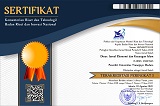Strategies to Enhance ZIS Donor Loyalty through Trust Building at Baitul Maal Hidayatullah East Kalimantan
Abstract
This study is motivated by the limited number of empirical investigations that specifically examine the direct effects of service quality, institutional image, communication, and donation convenience on donor trust, as well as its impact on the loyalty of ZIS (zakat, infaq, and sadaqah) donors. The novelty of this research lies in its focus on a causal relationship model that does not include any mediating variables—distinct from most prior studies which typically position trust merely as an intervening variable.
The primary aim of this research is to analyze the extent to which service quality, institutional image, communication, and donation convenience directly influence donor trust, and to assess the direct impact of donor trust on the loyalty of zakat, infaq, and sadaqah donors at the National Amil Zakat Institution (LAZNAS) Baitul Maal Hidayatullah in East Kalimantan.
A quantitative approach was employed using the Partial Least Squares Structural Equation Modeling (PLS-SEM) method. Primary data were collected through a structured questionnaire using a 5-point Likert scale, distributed to 240 active donors selected through purposive sampling. Data processing involved several stages, including validity and reliability testing, evaluation of the measurement model, and structural model assessment.
The results show that both service quality and institutional image have a positive and significant effect on donor trust. In contrast, communication and donation convenience exhibit a positive but statistically insignificant influence. Furthermore, donor trust is proven to have a direct and significant effect in enhancing sustained donor loyalty in ZIS contributions.
Keywords
References
Antonio, Muhammad Syafi’i, Bank Syariah Dari Teori Ke Praktek, Jakarta: Gema Insani Press, 2001.
Anshori, M. Y., Karya, D. F., Rahmania, A. A., & Elfita, R. A. (2022). Analisis Loyalitas Donatur Dan Brand Trust: Studi Pada Ydsf Al-Falah Surabaya. Journal Of Management And Business Review, 19(2), 92–107. Https://Doi.Org/10.34149/Jmbr.V19i2.316
Antonio, M. S. (2011). Bank Syariah: Dari Teori Ke Praktik. Gema Insani.
Assa’diyah, H., & Pramono, S. (2019). Kenapa Muzakki Percaya Kepada Lembaga Amil Zakat? Jurnal Akuntansi Dan Keuangan Islam. Https://Journal.Sebi.Ac.Id/Index.Php/Jaki/Article/View/68
Awaliah, D., Rahman, A., & Kuswana, D. (2020). Manajemen Strategik Customer Relationship Management (Crm) Dalam Menjaga Loyalitas Donatur. Tadbir Jurnal Manajemen Dakwah, 5(4), 337–356. Https://Doi.Org/10.15575/Tadbir.V5i4.2125
Basit, A. W., Jaenudin, M., & Ratnasari, R. T. (2022). Faktor Yang Menentukan Muzakki Berdonasi Kembali Di Lembaga Zakat. Jurnal Justisia Ekonomika Magister Hukum Ekonomi Syariah, 6(2). Https://Doi.Org/10.30651/Justeko.V6i2.15407
Berry, L. L., Morgan, R. (Rob) M., & Hunt, S. D. (1983). Relationship Marketing. American Marketing Association.
Bmh. (2025). Penghimpunan Bmh Perwakilan Kaltim Tahun 2020 – 2024.
Chin W, M. G. (1998). The Partial Least Squares Approach To Structural Formula Modeling. Advances In Hospitality And Leisure, 8(2)(January 1998), 5.
Cutlip, S. M., Center, A. H., & Broom, G. M. (2006). Effective Public Relations (9th Ed.). Pearson Education.
Davis, F. D. (1989). Perceived Usefulness, Perceived Ease Of Use, And User Acceptance Of Information Technology. Mis Quarterly, 13(3), 319. Https://Doi.Org/10.2307/249008
Gray, E. R., & Balmer, J. M. T. (1998). Managing Corporate Image And Corporate Reputation. Long Range Planning, 31(5), 695–702. Https://Doi.Org/10.1016/S0024-6301(98)00074-0
Hair, J. F., Hult, G. T. M., Ringle, C. M., & Sarstedt, M. (2021). Partial Least Squares Structural Equation Modeling (Pls-Sem) Using R. Springer.
Hair, J. F., Sarstedt, M., & Ringle, C. M. (2019). Rethinking Some Of The Rethinking Of Partial Least Squares. European Journal Of Marketing, 53(4), 566–584.
Henseler, J., & Sarstedt, M. (2013). Goodness-Of-Fit Indices For Partial Least Squares Path Modeling. Computational Statistics, 28(2), 565–580. Https://Doi.Org/10.1007/S00180-012-0317-1
Herianingrum, S., Reftrian, R., & ... (2018). The Influence Of Quality Of Islamic Service And Institution Image To Donor Trust At National Amil Zakat Institute (Laznas). Kne Social Sciences …. Https://Repository.Unair.Ac.Id/119223
Hidayatullah, E. I., & Purbasari, L. T. (2022). Analysing Repeat Alms Donation Behavior Via Digital Platform. Jurnal Ilmiah Ekonomi Islam, 8(1), 677. Https://Doi.Org/10.29040/Jiei.V8i1.4618
Jahar, A. S. (2015). Marketing Islam Through Zakat Institutions In Indonesia. Studia Islamika, 22(3), 405–442. Https://Doi.Org/10.15408/Sdi.V22i3.2353
Morgan, R. M., & Hunt, S. D. (1994). The Commitment-Trust Theory Of Relationship Marketing. Journal Of Marketing, 58(3), 20. Https://Doi.Org/10.2307/1252308
Musana, K., Syafuri, B., & Syarifudin, E. (2024). Pengaruh Kualitas Pelayanan Terhadap Loyalitas Muzakki Dalam Membayar Zis (Studi Pada Baznas Provinsi Banten). Ekonomica Sharia Jurnal Pemikiran Dan Pengembangan Ekonomi Syariah, 9(2), 297–314. Https://Doi.Org/10.36908/Esha.V9i2.921
Mutmainah, L., Berakon, I., & Yusfiarto, R. (2024). Does Financial Technology Improve Intention To Pay Zakat During National Economic Recovery? A Multi-Group Analysis. Journal Of Islamic Marketing, 15(6), 1583–1607. Https://Doi.Org/10.1108/Jima-09-2022-0268
Parasuraman, V. A. Z., & Berry, L. L. (1988). Servqual: A Multiple-Item Scale For Measuring Consumer Perceptions Of Service Quality. Journal Of Retailing, 64(1), 12–40.
Pematasari, C., & Huda, N. (2015). Analysis Of The Effects Of Zakat Collecting Institutions’ Service Quality On Muzakis’ Loyalty. In Journal Of Islamic Economics, Banking And …. Academia.Edu. Https://Www.Academia.Edu/Download/40842550/Jurnal_Ibtra_Januari-Maret_2015.Pdf
Ruslamsyah, E. (2018). Kualitas Pelayanan Dan Kepercayaan Donatur Serta Pengaruhnya Terhadap Loyalitas Donatur. Universitas Pendidikan Indonesia.
Safitri, D., & Nurkhin, A. (2019). Pengaruh Kualitas Pelayanan Terhadap Loyalitas Muzaki Melalui Kepuasan Muzaki Dan Kepercayaan Muzaki. Economic Education Analysis Journal. Https://Journal.Unnes.Ac.Id/Sju/Eeaj/Article/View/31479
Samsono, A. (2018). Analisis Faktor-Faktor Yang Mempengaruhi Loyalitas Berinfaq. Jurnal Bina Ummat Membina Dan Membentengi Ummat, 1(2), 15–55. Https://Doi.Org/10.38214/Jurnalbinaummatstidnatsir.V1i02.23
Shannon, C. E., & Weaver, W. (1949). The Mathematical Theory Of Communication. University Of Illinois Press.
Wymer, W., Becker, A., & Boenigk, S. (2021). The Antecedents Of Charity Trust And Its Influence On Charity Supportive Behavior. Journal Of Philanthropy And Marketing, 26(2). Https://Doi.Org/10.1002/Nvsm.1690
Yusfiarto, R., Nugraha, S. S., Pambudi, D. S., & Pambekti, G. T. (2022). Islamic Banking And Loyalty: Service Quality, Intimacy Or Religious Driven? Studies In Business And Economics, 17(2), 300–318. Https://Doi.Org/10.2478/Sbe-2022-0040
DOI: https://doi.org/10.21107/dinar.v12i2.31124
Refbacks
- There are currently no refbacks.
Copyright (c) 2025 Imam Salamun

This work is licensed under a Creative Commons Attribution-ShareAlike 4.0 International License.
Journal Dinar Indexed by:
Dinar: Jurnal Ekonomi dan Keuangan Islam by Universitas Trunojoyo Madura is licensed under a Creative Commons Attribution-ShareAlike 4.0 International License.






.png)










